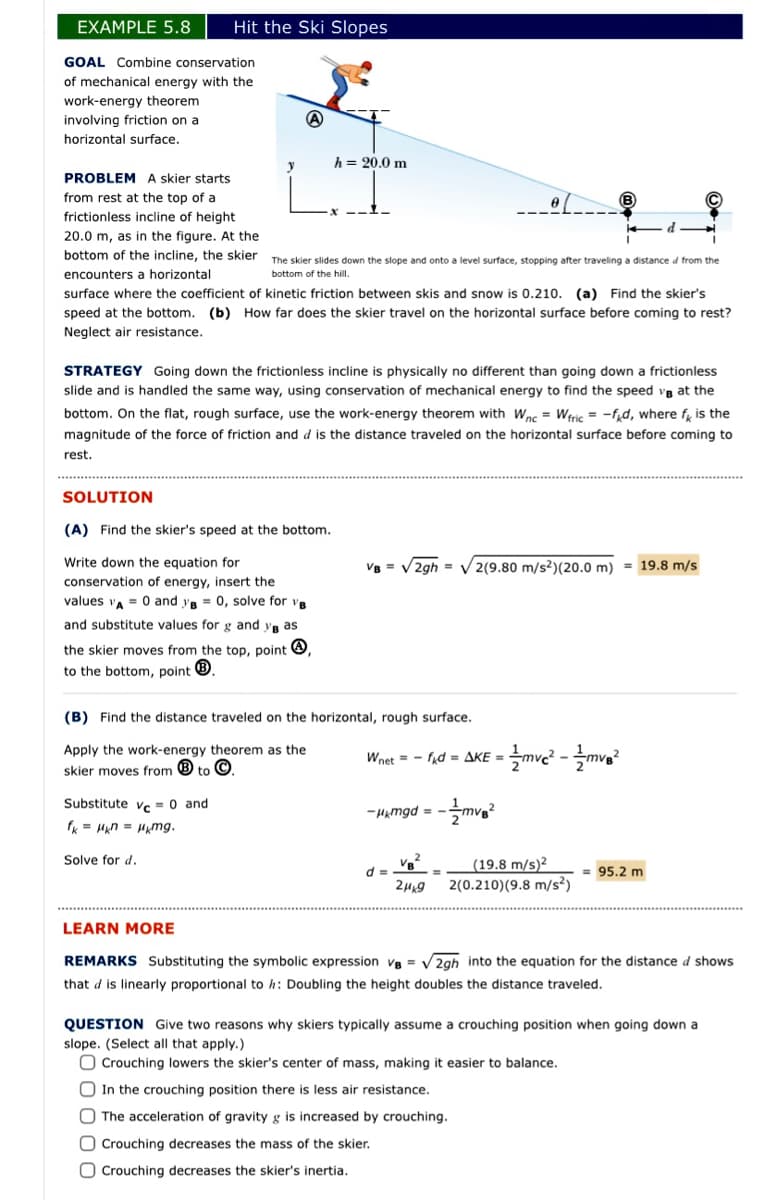GOAL Combine conservation of mechanical energy with the work-energy theorem involving friction on a horizontal surface. h = 20.0 m PROBLEM A skier starts from rest at the top of a frictionless incline of height 20.0 m, as in the figure. At the bottom of the incline, the skier The skier slides down the slope and onto a level surface, stopping after traveling a distance d from the encounters a horizontal bottom of the hill. surface where the coefficient of kinetic friction between skis and snow is 0.210. (a) Find the skier's speed at the bottom. (b) How far does the skier travel on the horizontal surface before coming to rest? Neglect air resistance.
GOAL Combine conservation of mechanical energy with the work-energy theorem involving friction on a horizontal surface. h = 20.0 m PROBLEM A skier starts from rest at the top of a frictionless incline of height 20.0 m, as in the figure. At the bottom of the incline, the skier The skier slides down the slope and onto a level surface, stopping after traveling a distance d from the encounters a horizontal bottom of the hill. surface where the coefficient of kinetic friction between skis and snow is 0.210. (a) Find the skier's speed at the bottom. (b) How far does the skier travel on the horizontal surface before coming to rest? Neglect air resistance.
College Physics
10th Edition
ISBN:9781285737027
Author:Raymond A. Serway, Chris Vuille
Publisher:Raymond A. Serway, Chris Vuille
Chapter5: Energy
Section: Chapter Questions
Problem 7P: A sledge loaded with bricks has a total mass of 18.0 kg and it pulled at constant speed by a rope...
Related questions
Topic Video
Question
Please answer the final question.

Transcribed Image Text:EXAMPLE 5.8
Hit the Ski Slopes
GOAL Combine conservation
of mechanical energy with the
work-energy theorem
involving friction on a
A
horizontal surface.
h = 20.0 m
y
PROBLEM A skier starts
from rest at the top of a
frictionless incline of height
20.0 m, as in the figure. At the
bottom of the incline, the skier The skier slides down the slope and onto a level surface, stopping after traveling a distance d from the
encounters a horizontal
surface where the coefficient of kinetic friction between skis and snow is 0.210. (a) Find the skier's
bottom of the hill.
speed at the bottom. (b) How far does the skier travel on the horizontal surface before coming to rest?
Neglect air resistance.
STRATEGY Going down the frictionless incline is physically no different than going down a frictionless
slide and is handled the same way, using conservation of mechanical energy to find the speed ve at the
bottom. On the flat, rough surface, use the work-energy theorem with Wp = Wtric = -f,d, where f, is the
nc
magnitude of the force of friction and d is the distance traveled on the horizontal surface before coming to
rest.
SOLUTION
(A) Find the skier's speed at the bottom.
Write down the equation for
VB = V2gh = V2(9.80 m/s²)(20.0 m) = 19.8 m/s
conservation of energy, insert the
values vA = 0 and yB = 0, solve for ve
and substitute values for g and ye as
the skier moves from the top, point O,
to the bottom, point ®.
(B) Find the distance traveled on the horizontal, rough surface.
Apply the work-energy theorem as the
skier moves from ® to ©.
Wnet = - fid = AKE = mve? - mvg?
Substitute ve = 0 and
-HAmgd = --mve?
fk = Hyn = Hmg.
Solve for d.
(19.8 m/s)²
2(0.210)(9.8 m/s²)
d =
= 95.2 m
LEARN MORE
REMARKS Substituting the symbolic expression Ve = v 2gh into the equation for the distance d shows
that d is linearly proportional to h: Doubling the height doubles the distance traveled.
QUESTION Give two reasons why skiers typically assume a crouching position when going down a
slope. (Select all that apply.)
O Crouching lowers the skier's center of mass, making it easier to balance.
In the crouching position there is less air resistance.
O The acceleration of gravity g is increased by crouching.
Crouching decreases the mass of the skier.
Crouching decreases the skier's inertia.
Expert Solution
This question has been solved!
Explore an expertly crafted, step-by-step solution for a thorough understanding of key concepts.
This is a popular solution!
Trending now
This is a popular solution!
Step by step
Solved in 3 steps with 3 images

Knowledge Booster
Learn more about
Need a deep-dive on the concept behind this application? Look no further. Learn more about this topic, physics and related others by exploring similar questions and additional content below.Recommended textbooks for you

College Physics
Physics
ISBN:
9781285737027
Author:
Raymond A. Serway, Chris Vuille
Publisher:
Cengage Learning

University Physics Volume 1
Physics
ISBN:
9781938168277
Author:
William Moebs, Samuel J. Ling, Jeff Sanny
Publisher:
OpenStax - Rice University

College Physics
Physics
ISBN:
9781938168000
Author:
Paul Peter Urone, Roger Hinrichs
Publisher:
OpenStax College

College Physics
Physics
ISBN:
9781285737027
Author:
Raymond A. Serway, Chris Vuille
Publisher:
Cengage Learning

University Physics Volume 1
Physics
ISBN:
9781938168277
Author:
William Moebs, Samuel J. Ling, Jeff Sanny
Publisher:
OpenStax - Rice University

College Physics
Physics
ISBN:
9781938168000
Author:
Paul Peter Urone, Roger Hinrichs
Publisher:
OpenStax College

Principles of Physics: A Calculus-Based Text
Physics
ISBN:
9781133104261
Author:
Raymond A. Serway, John W. Jewett
Publisher:
Cengage Learning

Physics for Scientists and Engineers with Modern …
Physics
ISBN:
9781337553292
Author:
Raymond A. Serway, John W. Jewett
Publisher:
Cengage Learning

Physics for Scientists and Engineers, Technology …
Physics
ISBN:
9781305116399
Author:
Raymond A. Serway, John W. Jewett
Publisher:
Cengage Learning